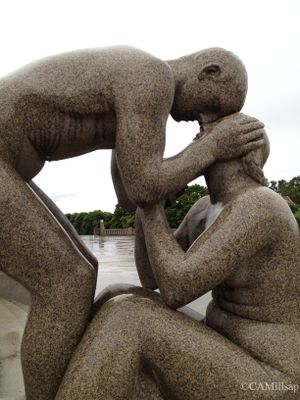Travel: Oslo’s Vigeland Sculpture Park
There was a soft summer rain falling, but that didn’t keep people away. Tucked under umbrellas, wrapped in raincoats, the crowd--locals and tourists like me--strolled through the main gate of Vigeland Sculpture Park near the center of Oslo, Norway. We all moved down the wide path and across the bridge lined with carved figures. Without the harsh glare of sunlight, the the rain seemed to soften and illuminate the sculptures, adding warm life to cold metal and stone.
Oslo’s Vigeland Sculpture Park is unlike any other; it showcases the work of only one man--Gustave Vigeland. In 1921 Vigeland, already an established artist, made an agreement with the city of Oslo. In return for a home and studio at Frogner Park, Vigeland would create a park built around the bulk of his work and it would forever belong to the city.
For 20 years, the last two decades of his life, Vigeland lived and worked there, creating more than 200 projects for the park. The work includes the impressive entrance, impressive two-dimensional iron gates, a bronze fountain with a tableau of the circle of life. The pinnacle is a five-story monolith of the bodies of men, women and children--more than 120 figures--carved from a single column of solid granite.
The bridge leading from the entrance to the crest of the hill is lined with more than 50 bronze figures, including the famous ”Sinnataggen” a furious toddler in captured in full tantrum. The figure of the angry baby has become the park’s signature and his left hand shines from the constant touching and rubbing of visitors.
The theme of the garden is life and all its stages. Vigeland’s figures show mankind from birth to death and the sculptures are arranged in groups along a series of pathways.
Gustave Vigeland’s figures, especially those in granite, are massive, but there is a striking delicacy to each piece. Especially in the rain. I found myself circling them, looking deeply at the expressions on each face, at the language of each body. Taking one photo after another, trying to capture what the artist had expressed.
The true magic of Vigeland Sculpture Park is the way the sculptor imbued granite and bronze with human emotion. His figures carry the joy, anguish, fear and desire of life. They draw you in and stay with you after you leave.
Cheryl-Anne Millsap is a travel writer whose audio essays can be heard each week on Spokane Public Radio and on public radio stations across the country. She is the author of Home Planet: A Life in Four Seasons and blogs about antiques and collectibles at Treasure Hunting. She can be reached at catmillsap@gmail.com
